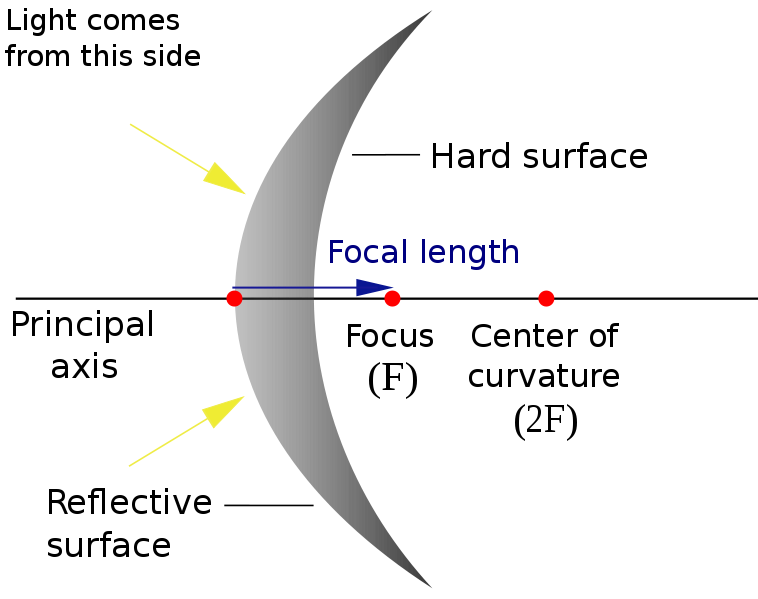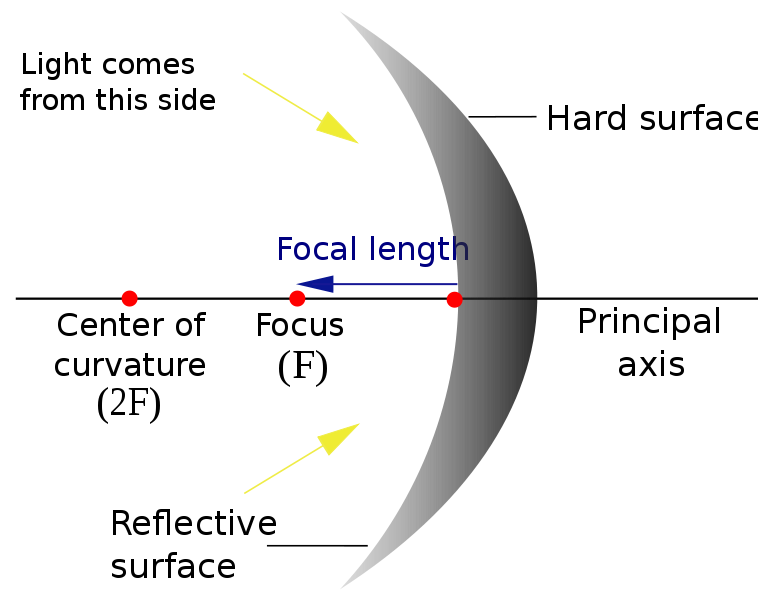Spherical Mirror Formula - Characteristics, Table, FAQs
Introduction
In this article, our focus will be on the spherical mirror, its formula, sign convention, sign convention for mirror and lenses etc.
What is a spherical mirror?
A spherical mirror is a mirror that is in the shape of a piece cut from a spherical surface.
It is of two types:-
- Convex mirror
- Concave mirror
Convex mirror
Convex Mirror is a curved mirror, the reflective surface of which curves towards the light source (toward outside). These bulging surfaces reflect light outwards and are not used to focus light. These mirrors form a virtual image because the focal point (F) and the center of curvature (2F) are imaginary points on the mirror that cannot be reached. This results in the formation of images that cannot be projected on a screen because the image is inside the mirror. The image appears smaller than the object from a distance, but becomes larger as the object gets closer to the mirror.
Characteristics :
- A convex mirror is also known as a diverging mirror because this mirror scatters light when it hits its reflective surface.
- Virtual, upright, and reduced images are always created or viewed with convex mirrors, regardless of the distance between the object and the mirror.

Also read -
- NCERT Solutions for Class 11 Physics
- NCERT Solutions for Class 12 Physics
- NCERT Solutions for All Subjects
Concave mirror
We know that a section of a reflective sphere is a spherical mirror. If the reflective surface is on the inward curved side, it is a concave mirror. Concave mirrors are often used as a shaving mirror or by dentists and even in telescopes. The reflected image is enlarged, but the field of view is limited. Concave mirrors are also called collective mirrors.
Characteristics:
- Light after reflection converges at a point where it hits and is reflected from the reflective surface of the concave mirror. That is why it is also known as a collective mirror.
- When the collective mirror is placed very close to the object, an enlarged virtual image is observed.
- It is observed that with the increase in the distance between object and the mirror, there will be a decrease in the size of the image and a real image emerges.
- The image created by the concave mirror can be small or magnified, real or virtual.

What is a mirror formula?
It is an equation that relates the distance of the object and the distance of the image to the focal length and is known as the mirror equation.
In a spherical mirror:
- The distance between the object and the mirror is called the object distance (u).
- The distance between the image and the mirror is called the image distance (v).
- Focal length (f) is the line connecting principal focus and the mirror.
The relation between object distance, image distance, and focal length is given as:
![]()
![]()
u be the object distance
v be the image distance
f be the focal length, ![]()
R be the spherical mirror’s radius of curvature
Related Topics Link, |
What is sign convention?
The Sign Convention is a set of rules to establish signs for the distance of the image, the distance of objects, the focal length, etc.
Rules for sign convention
- From the mirror the distances must be measured.
- Distances measured in the direction of incidence of light must be evaluated as positive and in the opposite direction of incidence of light as negative.
- Object height and image height are positive when measured from the axis up and negative when measured down.
- Focal length and radius of curvature are negative for a concave mirror and positive for a convex mirror.
New cartesian sign convention/ sign convention for reflection by spherical mirror
- The optical center of the lens is taken into account for the measurement of all distances.
- If distances are measured in the opposite direction of incident light, they are considered negative.
- If distances are measured in the same direction as the incident light, they are considered positive.
- If the heights are measured upward and perpendicular to the principal axis, they are considered positive.
- If the heights are measured downward and perpendicular to the principal axis, they are considered negative.
Sign convention for concave mirror
- Since the object is always placed in front of the mirror, the sign of the object distance is assumed to be negative.
- Since the center of curvature and the focal point are in front of the concave mirror, the signs of the radius of curvature and the focal length of the concave mirror are evaluated as negative.
- When creating an image in front of the mirror, the image distance is taken as - (negative) and when creating an image behind the mirror, the image distance is taken as + (positive).
- Image height is taken as positive for erect images and negative for inverted images
Sign convention for convex mirror
- Since the object is always placed in front of the mirror, the sign of the object distance is assumed to be negative.
- Since the center of curvature and the focal point lie behind the convex mirror, the signs of the radius of curvature and the focal length are assumed to be + (positive) for the convex mirror.
- The image distance in a convex mirror is positive as the image falls back of the mirror.
- A convex mirror always creates an erect image, so the image height is evaluated as positive.
Also Read:
Sign convention table
Types of lenses | U | V | f | Height of the image | Height of the object |
Convex | Negative | Real image- positive Virtual image- negative | Real image- Positive No virtual focus | Real image-negative Virtual image-positive | Positive |
| Concave | Negative | No real image is formed Virtual image-negative | No real focus Virtual image- Negative | No real image is formed Virtual image-positive | Positive |
Questions on spherical mirrors
1. The focal length and the object distance in case of a concave mirror are 3 cm and 6 cm respectively. Calculate the image distance.
Ans:
From the mirror formula,
![]()
Using sign convention for concave mirror,
![]()
u= object distance= 6cm
v= image distance
f= focal length of the concave mirror = 3 cm
putting the values,
![]()
![]()
![]()
Image distance of mirror is -6cm
2. The focal length and the object distance in case of a convex mirror are 6 cm and 8 cm respectively. Calculate the image distance.
Ans.
From the mirror formula,
![]()
Using sign convention for convex mirror,
![]()
u= object distance= 8cm
f= focal length of the convex mirror = 6 cm
putting the values,
![]()
![]()
![]()
Image distance of mirror is ![]() cm
cm
Also check-
- NCERT Exemplar Class 11th Physics Solutions
- NCERT Exemplar Class 12th Physics Solutions
- NCERT Exemplar Solutions for All Subjects
NCERT Physics Notes:
Frequently Asked Questions (FAQs)
From the mirror the distances must be measured.
Distances measured in the direction of incidence of light must be evaluated as positive and in the opposite direction of incidence of light as negative.
Object height and image height are positive when measured from the axis up and negative when measured down.
Focal length and radius of curvature are negative for a concave mirror and positive for a convex mirror.
- The optical center of the lens is taken into account for the measurement of all distances.
- If distances are measured based on the direction of incident light, they are considered negative.
- If distances are measured in the same direction as the incident light, they are considered positive.
- If the heights are measured upward and perpendicular to the principal axis, they are considered positive.
- If the heights are measured downward and perpendicular to the principal axis, they are considered negative
Magnification of concave mirror/ magnification of mirror is given by,
M=vu where v is the image distance, and u is the object distance.
The line connecting the pole and the principal focus of a mirror is called focal length of a spherical mirror.
Length of image divided by the length of the object is called lateral magnification or longitudinal magnification.
The value of angle of the image observed through the telescope divided by the angle of the same object observed in the absence of the telescope is called angular magnification.
The Sign Convention is a set of rules to establish signs for the distance of the image, the distance of objects, the focal length, etc.